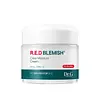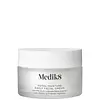What's inside
What's inside
 Key Ingredients
Key Ingredients

 Benefits
Benefits

 Concerns
Concerns

 Ingredients Side-by-side
Ingredients Side-by-side

Water
Skin ConditioningGlycerin
Humectant2,3-Butanediol
HumectantHydrogenated Poly(C6-14 Olefin)
EmollientCentella Asiatica Extract
CleansingNiacinamide
SmoothingBetaine
HumectantVinyldimethicone
Cyclohexasiloxane
Emollient1,2-Hexanediol
Skin ConditioningCetyl Ethylhexanoate
EmollientHydrogenated Polydecene
EmollientJojoba Esters
EmollientHydrogenated Lecithin
EmulsifyingSodium Hyaluronate
HumectantMacadamia Ternifolia Seed Oil
EmollientHydrogenated Rapeseed Oil
EmollientCaprylic/Capric Triglyceride
MaskingHydroxyethyl Acrylate/Sodium Acryloyldimethyl Taurate Copolymer
Emulsion StabilisingHexyldecyl Laurate
EmollientHexyldecanol
EmollientSilica
AbrasiveAmmonium Acryloyldimethyltaurate/Vp Copolymer
C14-22 Alcohols
Emulsion StabilisingArachidyl Alcohol
EmollientPalmitic Acid
EmollientC12-20 Alkyl Glucoside
EmulsifyingGlyceryl Stearate
EmollientDipropylene Glycol
HumectantAllantoin
Skin ConditioningStearic Acid
CleansingBehenyl Alcohol
EmollientArachidyl Glucoside
EmulsifyingCarbomer
Emulsion StabilisingSodium Stearoyl Glutamate
CleansingSorbitan Isostearate
EmulsifyingDisodium EDTA
Panthenol
Skin ConditioningSucrose Distearate
EmollientButylene Glycol
HumectantGlucose
HumectantMyristic Acid
CleansingCeramide NP
Skin ConditioningMadecassoside
AntioxidantAsiaticoside
AntioxidantMadecassic Acid
Skin ConditioningAsiatic Acid
Skin ConditioningPhytosphingosine
Skin ConditioningHydroxyacetophenone
AntioxidantEthylhexylglycerin
Skin ConditioningWater, Glycerin, 2,3-Butanediol, Hydrogenated Poly(C6-14 Olefin), Centella Asiatica Extract, Niacinamide, Betaine, Vinyldimethicone, Cyclohexasiloxane, 1,2-Hexanediol, Cetyl Ethylhexanoate, Hydrogenated Polydecene, Jojoba Esters, Hydrogenated Lecithin, Sodium Hyaluronate, Macadamia Ternifolia Seed Oil, Hydrogenated Rapeseed Oil, Caprylic/Capric Triglyceride, Hydroxyethyl Acrylate/Sodium Acryloyldimethyl Taurate Copolymer, Hexyldecyl Laurate, Hexyldecanol, Silica, Ammonium Acryloyldimethyltaurate/Vp Copolymer, C14-22 Alcohols, Arachidyl Alcohol, Palmitic Acid, C12-20 Alkyl Glucoside, Glyceryl Stearate, Dipropylene Glycol, Allantoin, Stearic Acid, Behenyl Alcohol, Arachidyl Glucoside, Carbomer, Sodium Stearoyl Glutamate, Sorbitan Isostearate, Disodium EDTA, Panthenol, Sucrose Distearate, Butylene Glycol, Glucose, Myristic Acid, Ceramide NP, Madecassoside, Asiaticoside, Madecassic Acid, Asiatic Acid, Phytosphingosine, Hydroxyacetophenone, Ethylhexylglycerin
Water
Skin ConditioningGlycerin
HumectantDimethicone
EmollientSqualane
EmollientCaprylic/Capric Triglyceride
MaskingBis-PEG-18 Methyl Ether Dimethyl Silane
EmollientPentaerythrityl Tetraethylhexanoate
EmollientPropanediol
SolventArachidyl Alcohol
EmollientCetearyl Alcohol
EmollientInulin
Skin ConditioningBehenyl Alcohol
EmollientPhenoxyethanol
PreservativeArachidyl Glucoside
EmulsifyingTocopheryl Acetate
AntioxidantCaprylyl Glycol
EmollientLinoleic Acid
CleansingSaccharomyces Ferment Filtrate
HumectantGlyceryl Glucoside
HumectantSodium Hyaluronate
HumectantAcetyl Heptapeptide-4
HumectantLinolenic Acid
CleansingCetearyl Glucoside
EmulsifyingSodium Polyacryloyldimethyl Taurate
Emulsion StabilisingDiglycerin
HumectantCeramide NP
Skin ConditioningSodium PCA
HumectantUrea
BufferingCarbomer
Emulsion StabilisingDisodium EDTA
Hydrogenated Polydecene
EmollientEthylhexylglycerin
Skin ConditioningXanthan Gum
EmulsifyingAcrylates/C10-30 Alkyl Acrylate Crosspolymer
Emulsion StabilisingSodium Hydroxide
BufferingLactic Acid
BufferingLysine
Skin ConditioningPCA
HumectantSorbitol
HumectantButylene Glycol
Humectant1,2-Hexanediol
Skin ConditioningTrideceth-10
CleansingTocopherol
AntioxidantHydrolyzed Wheat Protein
Skin ConditioningAllantoin
Skin ConditioningOryza Sativa Lees Extract
Skin ConditioningWater, Glycerin, Dimethicone, Squalane, Caprylic/Capric Triglyceride, Bis-PEG-18 Methyl Ether Dimethyl Silane, Pentaerythrityl Tetraethylhexanoate, Propanediol, Arachidyl Alcohol, Cetearyl Alcohol, Inulin, Behenyl Alcohol, Phenoxyethanol, Arachidyl Glucoside, Tocopheryl Acetate, Caprylyl Glycol, Linoleic Acid, Saccharomyces Ferment Filtrate, Glyceryl Glucoside, Sodium Hyaluronate, Acetyl Heptapeptide-4, Linolenic Acid, Cetearyl Glucoside, Sodium Polyacryloyldimethyl Taurate, Diglycerin, Ceramide NP, Sodium PCA, Urea, Carbomer, Disodium EDTA, Hydrogenated Polydecene, Ethylhexylglycerin, Xanthan Gum, Acrylates/C10-30 Alkyl Acrylate Crosspolymer, Sodium Hydroxide, Lactic Acid, Lysine, PCA, Sorbitol, Butylene Glycol, 1,2-Hexanediol, Trideceth-10, Tocopherol, Hydrolyzed Wheat Protein, Allantoin, Oryza Sativa Lees Extract
 Reviews
Reviews

Ingredients Explained
These ingredients are found in both products.
Ingredients higher up in an ingredient list are typically present in a larger amount.
1,2-Hexanediol is a synthetic liquid and another multi-functional powerhouse.
It is a:
- Humectant, drawing moisture into the skin
- Emollient, helping to soften skin
- Solvent, dispersing and stabilizing formulas
- Preservative booster, enhancing the antimicrobial activity of other preservatives
Allantoin is a soothing ingredient known for its protective and moisturizingg properties. Because of this, it is often added to products with strong active ingredients.
Studies show higher concentrations of this ingredient can promote wound healing.
Though it can be derived from the comfrey plant, allantoin is produced synthetically for cosmetic products to ensure purity.
Learn more about AllantoinArachidyl Alcohol is a fatty alcohol made from peanut oil. It is an emollient, emulsifier, and thickener.
You'll most likely find this ingredient as an emulsifier in water-based cosmetics.
We don't have a description for Arachidyl Glucoside yet.
Behenyl Alcohol is a type of fatty alcohol (these are different from the drying, solvent alcohols).
Fatty Alcohols have hydrating properties and are most often used as an emollient or to thicken a product. They are usually derived from natural fats and oils; behenyl alcohol is derived from the fats of vegetable oils.
Emollients help keep your skin soft and hydrated by creating a film that traps moisture in.
In 2000, Behenyl Alcohol was approved by the US as medicine to reduce the duration of cold sores.
Learn more about Behenyl AlcoholButylene Glycol (or BG) is used within cosmetic products for a few different reasons:
Overall, Butylene Glycol is a safe and well-rounded ingredient that works well with other ingredients.
Though this ingredient works well with most skin types, some people with sensitive skin may experience a reaction such as allergic rashes, closed comedones, or itchiness.
Learn more about Butylene GlycolThis ingredient is an emollient, solvent, and texture enhancer. It is considered a skin-softener by helping the skin prevent moisture loss.
It helps thicken a product's formula and makes it easier to spread by dissolving clumping compounds.
Caprylic Triglyceride is made by combining glycerin with coconut oil, forming a clear liquid.
While there is an assumption Caprylic Triglyceride can clog pores due to it being derived from coconut oil, there is no research supporting this.
Learn more about Caprylic/Capric TriglycerideCarbomer is a polymer of acrylic acid. Its main role is to create a gel consistency.
A high amount of carbomer can cause pilling or balling up of products. Don't worry, most products contain 1% or less of carbomer.
Ceramide NP is a type of ceramide.
Ceramides are intercellular lipids naturally found in our skin that bonds dead skin cells together to create a barrier. They are known for their ability to hold water and thus are a great ingredient for dry skin.
Ceramides are an important building block for our skin barrier. A stronger barrier helps the skin look more firm and hydrated. By bolstering the skin ceramides act as a barrier against irritating ingredients. This can help with inflammation as well.
If you would like to eat ceramides, sweet potatoes contain a small amount.
Read more about other common types of ceramides here:
Ceramide AP
Ceramide EOP
Disodium EDTA plays a role in making products more stable by aiding other preservatives.
It is a chelating agent, meaning it neutralizes metal ions that may be found in a product.
Disodium EDTA is a salt of edetic acid and is found to be safe in cosmetic ingredients.
Learn more about Disodium EDTAEthylhexylglycerin (we can't pronounce this either) is commonly used as a preservative and skin softener. It is derived from glyceryl.
You might see Ethylhexylglycerin often paired with other preservatives such as phenoxyethanol. Ethylhexylglycerin has been found to increase the effectiveness of these other preservatives.
Glycerin is already naturally found in your skin. It helps moisturize and protect your skin.
A study from 2016 found glycerin to be more effective as a humectant than AHAs and hyaluronic acid.
As a humectant, it helps the skin stay hydrated by pulling moisture to your skin. The low molecular weight of glycerin allows it to pull moisture into the deeper layers of your skin.
Hydrated skin improves your skin barrier; Your skin barrier helps protect against irritants and bacteria.
Glycerin has also been found to have antimicrobial and antiviral properties. Due to these properties, glycerin is often used in wound and burn treatments.
In cosmetics, glycerin is usually derived from plants such as soybean or palm. However, it can also be sourced from animals, such as tallow or animal fat.
This ingredient is organic, colorless, odorless, and non-toxic.
Glycerin is the name for this ingredient in American English. British English uses Glycerol/Glycerine.
Learn more about GlycerinHydrogenated Polydecene is an emollient. It creates a non-occlusive film on the skin that offers extra protection for your skin barrier.
The texture of Hydrogenated Polydecene ranges from light and silky to rich.
Hydrogenated Polydecene is the end compound of controlled hydrogenation of Polydecene.
Learn more about Hydrogenated PolydeceneSodium Hyaluronate is hyaluronic acid's salt form. It is commonly derived from the sodium salt of hyaluronic acid.
Like hyaluronic acid, it is great at holding water and acts as a humectant. This makes it a great skin hydrating ingredient.
Sodium Hyaluronate is naturally occurring in our bodies and is mostly found in eye fluid and joints.
These are some other common types of Hyaluronic Acid:
Learn more about Sodium HyaluronateWater. It's the most common cosmetic ingredient of all. You'll usually see it at the top of ingredient lists, meaning that it makes up the largest part of the product.
So why is it so popular? Water most often acts as a solvent - this means that it helps dissolve other ingredients into the formulation.
You'll also recognize water as that liquid we all need to stay alive. If you see this, drink a glass of water. Stay hydrated!
Learn more about Water